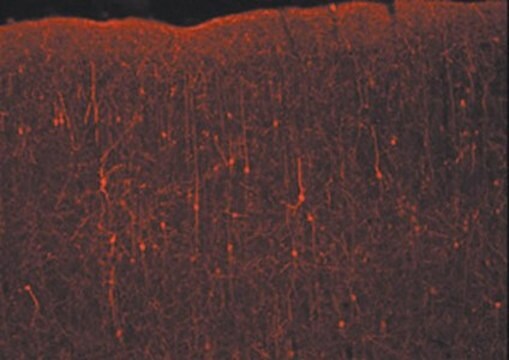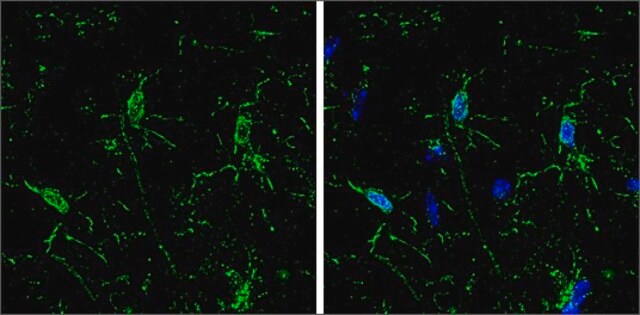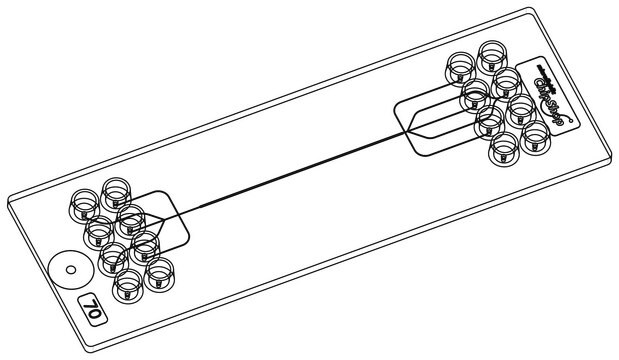AP192F
Donkey Anti-Mouse IgG Antibody, FITC conjugate, Species Adsorbed
Chemicon®, from donkey
Sign Into View Organizational & Contract Pricing
All Photos(1)
About This Item
UNSPSC Code:
12352203
eCl@ss:
32160702
NACRES:
NA.46
Recommended Products
biological source
donkey
Quality Level
conjugate
FITC conjugate
antibody form
affinity purified immunoglobulin
antibody product type
secondary antibodies
clone
polyclonal
species reactivity
mouse
manufacturer/tradename
Chemicon®
technique(s)
immunofluorescence: suitable
shipped in
wet ice
target post-translational modification
unmodified
General description
Immunoglobulin G (IgG), is one of the most abundant proteins in human serum with normal levels between 8-17 mg/mL in adult blood. IgG is important for our defence against microorganisms and the molecules are produced by B lymphocytes as a part of our adaptive immune response. The IgG molecule has two separate functions; to bind to the pathogen that elicited the response and to recruit other cells and molecules to destroy the antigen. The variability of the IgG pool is generated by somatic recombination and the number of specificities in an individual at a given time point is estimated to be 1011 variants.
Specificity
Specific for Mouse IgG.
Application
Detect Donkey Mouse IgG using this Donkey anti-Mouse IgG Antibody, FITC conjugate, Species Adsorbed validated for use in IF.
Research Category
Secondary & Control Antibodies
Secondary & Control Antibodies
Research Sub Category
Secondary Antibodies Adsorbed for Dual Labeling
Secondary Antibodies Adsorbed for Dual Labeling
Suggested dilution for most applications: 1:50-1:200.
Optimal working dilutions must be determined by the end user.
Optimal working dilutions must be determined by the end user.
Physical form
ImmunoAffinity Purified
Lyophilized. Buffer = 0.02 M Sodium Phosphate, 0.25 M NaCl, pH 7.6, with 15 mg/mL BSA and 0.1% sodium azide.
RECONSTITUTION:
Reconstitute to 1 mg/mL with sterile distilled water.
F/P RATIO:
15 micrograms FITC per mg of antibody.
RECONSTITUTION:
Reconstitute to 1 mg/mL with sterile distilled water.
F/P RATIO:
15 micrograms FITC per mg of antibody.
Storage and Stability
Maintain lyophilized product at 2–8°C for up to 12 months. After reconstitution the product is stable for several weeks at 2–8°C as an undiluted liquid. For extended storage after reconstitution, add an equal volume of glycerol to make a final concentration of 50% glycerol followed by storage at -20°C in undiluted aliquots for up to 12 months. Please note the concentration of protein (and buffer salts) will decrease to one-half of the original after the addition of glycerol. Avoid repeated freeze/thaw cycles.
Legal Information
CHEMICON is a registered trademark of Merck KGaA, Darmstadt, Germany
Disclaimer
Unless otherwise stated in our catalog or other company documentation accompanying the product(s), our products are intended for research use only and are not to be used for any other purpose, which includes but is not limited to, unauthorized commercial uses, in vitro diagnostic uses, ex vivo or in vivo therapeutic uses or any type of consumption or application to humans or animals.
Not finding the right product?
Try our Product Selector Tool.
hcodes
pcodes
Hazard Classifications
Aquatic Chronic 3
Storage Class
11 - Combustible Solids
wgk_germany
WGK 3
Certificates of Analysis (COA)
Search for Certificates of Analysis (COA) by entering the products Lot/Batch Number. Lot and Batch Numbers can be found on a product’s label following the words ‘Lot’ or ‘Batch’.
Already Own This Product?
Find documentation for the products that you have recently purchased in the Document Library.
The use of dentin matrix scaffold and dental follicle cells for dentin regeneration.
Weihua Guo,Yong He,Xiaojun Zhang,Wei Lu,Chunmei Wang,Hua Yu,Yuan Liu,Yuan Li,Yalei Zhou et al.
Biomaterials null
Ryosuke Saigusa et al.
Proceedings of the National Academy of Sciences of the United States of America, 112(49), 15136-15141 (2015-11-26)
Systemic sclerosis (SSc) is a multisystem autoimmune disorder with clinical manifestations resulting from tissue fibrosis and extensive vasculopathy. A potential disease susceptibility gene for SSc is IFN regulatory factor 5 (IRF5), whose SNP is associated with milder clinical manifestations; however
Odontogenic potential of mesenchymal cells from hair follicle dermal papilla.
Gang Wu, Zhi-Hong Deng, Xiao-Ju Fan, Zhao-Feng Ma, Ya-Juan Sun, Dan-Dan Ma, Jun-Jie Wu et al.
Stem Cells and Development null
Tooth root regeneration using dental follicle cell sheets in combination with a dentin matrix - based scaffold.
Bo Yang,Gang Chen,Jie Li,Qing Zou,Dan Xie,Yali Chen,Hang Wang,Xiaohui Zheng,Jie Long et al.
Biomaterials null
Weihua Guo et al.
Cell transplantation, 23(2), 181-194 (2013-02-01)
Cell transplantation has emerged as a novel therapeutic strategy for periodontitis, and the adoption of cell pellet offers advantages by secreting abundant extracellular matrix (ECM) and eliminating the adverse effect of cell carriers. This study aimed to fabricate scaffold-free periodontal
Our team of scientists has experience in all areas of research including Life Science, Material Science, Chemical Synthesis, Chromatography, Analytical and many others.
Contact Technical Service







